Hatano Y., Katsumura Y., Mozumder A. (Eds.) Charged Particle and Photon Interactions with Matter - Recent Advances, Applications, and Interfaces
Подождите немного. Документ загружается.

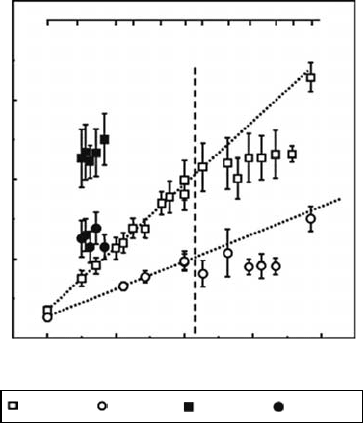
300 Charged Particle and Photon Interactions with Matter
and depended on cluster size (Paik etal., 2004). Study of the dynamics of electrons in clusters of
ammonia by time-resolved photoelectron spectra also showed ultrafast p → s conversion that results
in the formation of a coherent wave packet on a “hot” s-like state, but the observed solvation dynam-
ics differs from that of electrons in water cages (Lee etal., 2008). This difference is explained by
the different solvent motions for electron interaction in water (libration), in ammonia (phonon-like),
and the extent of cage rigidity.
Over the last decade, technological advancements have generated many results and rapid prog-
ress in understanding the properties of the solvated electron. The simplied picture of a “particle
in a box” must be revised. Recent results showed that, for electron solvation dynamics, the step-
wise mechanism involving different excited states and/or species is not accurate. The electron
solvation dynamics appears as a complex relaxation process with nonhomogeneous kinetics and,
to get common features and reliable time constants, global spectro-kinetics analysis is necessary.
Moreover, the answers of several questions dealing with the nature of the solvated electron and
the dynamics of its formation require improvements in quantum chemical and molecular dynam-
ics simulations in order to get a more realistic picture on the electron solvation process in many
solvents.
12.4 spur reaCtions and time-dependent radiCal yields
The ionization–excitation processes induced by energetic electrons, by nature, exhibit a stochastic
character. As a consequence, the radiolytic species are heterogeneously distributed in small clus-
ters, called spurs, formed along the radiation tracks. The description of these initial spurs in terms
of nature, numbers, and spatial repartition of primary radicals, as well as the distribution of these
spurs along the radiation tracks are the aims of many experimental and theoretical research efforts
in order to predict the evolution of a system irradiated by an ionizing radiation. In this section, we
present the recent contributions to our understanding of the spurs chemistry that have been obtained
by picosecond pulse-radiolysis methods. We rst present the signicant progress achieved during
the last decade and the actual state-of-the-art status of picosecond pulse-radiolysis setups, most of
600
400
Excited state lifetime (fs)
200
0
0.00
(D
2
O)
n, l
(H
2
O)
n, l
(D
2
O)
n, ll
(H
2
O)
n, ll
0.02 0.04
1/n
∞ 100 50 40 30 2522 19 17 15 13
n
0.06 0.08
Figure 12.12 Internal conversion lifetimes of the p → s relaxation for isomer I and II water clusters as a
function of cluster size. (Reprinted from Ehrler, O.T. and Neumark, D.M., Acc. Chem. Res., 42, 769, 2009.
With
permission.)
Time-Resolved Study on Nonhomogeneous Chemistry Induced in Polar Solvents 301
them based on laser-driven photocathode accelerators. The new emerging generation of ultrafast
pulse-radiolysis facilities is also presented. The second part of this section gives a survey of the
most recent experimental results obtained concerning the initial radiolytic yields, G-values, and the
spurs
reactivity in aqueous solutions, alcohols, and tetrahydrofuran.
12.4.1 ultrafaSt pulSe-radiolySiS SetupS for the Study of Spur reactionS
12.4.1.1 goals of ultrafast pulse-radiolysis measurements
Two different approaches can be used to model the spurs reactions chemistry, the deterministic
(LaVerne and Pimblott, 1991; Swiatla-Wojcik and Buxton, 1995) and the stochastic (Pimblott and
LaVerne, 1997; Cobut etal., 1998; Frongillo etal., 1998; du Penhoat etal., 2000) approach. The
deterministic model is based on the concept of an average spur at the end of the physicochemical
stage. It contains all the initial radiolytic products in certain yields and spatial distributions and in
thermal equilibrium with the liquid. For low LET radiation, the spurs are treated as isolated spheres
with a Gaussian distribution of each species. In this approach, the initial G-value and the spatial
distribution of each radiolytic species are empirical parameters adjusted to t the experimental data.
A set of coupled differential equations are solved to obtain the nonhomogeneous kinetics of the spur
processes and diffusion. So, the deterministic simulations are well adapted to study the radiolytic
events at the nonhomogeneous stage and, providing a realistic track description, they are capable
of good predictions of the time-dependent G-values. However, as the model is based on the concept
of average spurs, it fails to take into account nonnegligible effects like overlapping of spurs that is
important for tracks of high LET radiation. The deterministic approach also gives a poor descrip-
tion
of micro-heterogeneous media.
On
the other hand, the stochastic approaches are based on Monte Carlo calculations to directly
generate the initial spatial distribution and yields of the radiolytic species at the pre-chemical stage
using the cross section of the interactions between the charged particles and the solvents. Hence,
despite a higher computing cost, the stochastic simulations provide much more fundamental insight
into charged-particle interactions and track-structures. Recent works have shown the ability to
model the complex radiation-track and chemistry of high LET radiation. However, the accuracy of
these simulations strongly depends on the value of the interaction cross sections. So far, uncertain-
ties still remain for the inelastic cross sections, particularly, those associated with the low energetic
secondary electrons (E < 100eV) that play an important role in radiolytic events.
In order to validate and improve the models of the radiation-induced chemistry, there is a need
for providing experimental kinetics measured with a high temporal resolution and a very good sig-
nal-to-noise (S/N) ratio. Indeed, many reported studies illustrate how the spur models are strongly
sensitive to experimental parameters. For example, the rst deterministic simulations were based on
the initial G-value of hydrated electrons G(
e
aq
−
) = 5 × 10
−7
mol J
−1
and, lead to an initial spur radius
for the
e
aq
−
, r = 2.3 nm (Swiatla-Wojcik and Buxton, 1995). Later, with the revised G-value,G(
e
aq
−
) =
4.3
× 10
−7
mol J
−1
, this radius was increased to 3.8nm (Swiatla-Wojcik and Buxton, 2000).
The time evolution of the radiolytic yield can be measured by scavenging methods or time-
resolved measurements. The scavenging methods are particularly well suited for the studies of the
radiolysis of diluted solutions (typically up to 10
−3
mol L
−1
). Using a high concentration of scaven-
ger, or a high scavenging power, intra-spur scavenging is also possible. Buxton has exhaustively
reviewed the considerable contribution of scavenging studies to our understanding of the initial
G-values and spurs reactions (Buxton, 2004). The scavenging method remains the only one capable
of providing the evolution of yield of non-absorbing species like H
•
, H
2
, or H
2
O
2
, but it is limited
mostly because a given scavenger or a product of the scavenging reaction might react with several
primary radicals in the spurs. Alternatively, picosecond pulse-radiolysis experiments allow for the
direct measurement of initial G-values at the earliest point in time during the physicochemical stage
of the radiolytic events and can provide the full temporal evolution of the radiolytic species for
comparison with the simulations.
302 Charged Particle and Photon Interactions with Matter
12.4.1.2 picosecond pulse-radiolysis systems: a short story and the state of the art
The rst part of the ultrafast pulse-radiolysis story started during the early 1970s and extended to
the mid-1980s. At that time, the electron bunches were emitted by thermionic guns. The rst pulse-
radiolysis experiments were performed using a bunch of picosecond electrons pulses that were sepa-
rated by 350ps as the pump beam (Bronskil etal., 1970). This type of system was also implemented
later during the mid-1980s in Japan (Sumiyoshi and Katayama, 1982; Sumiyoshi etal., 1985). The
Cherenkov light pulses generated in the air by the accelerated electrons were used as the optical
probe. The time resolution and the temporal window of the measured kinetics were limited by the
temporal structure of electron bunches. In 1975, at the Argonne National Laboratory, United States,
the temporal window was extended to several nanoseconds by using single electron pulse generation
(Jonah, 1975; Jonah etal., 1976). An analogue but more advanced conguration named “twin linac
pulse-radiolysis system” (Kobayashi and Tabata, 1985; Tabata etal., 1985) was developed later at
the Tokyo University, Japan; a rst linac was used for the pulse irradiation, while a second generated
the
synchronized Cherenkov optical probe.
The
second phase of the ultrafast pulse-radiolysis history ran from the 1990s to the end of the
2000s and was associated with remarkable progress in shortening the electron bunch duration and
the time resolution of the experiments. Shortening of the electron bunch duration down to 800fs
(Uesaka etal., 1994) was achieved by the implementation of magnetic pulse compressor on the
S-band linac at NERL (Tokyo). Then, a similar device was developed at ISIR (Osaka) to compress
the width of 30 ps electrons bunch down to 125fs (Kozawa etal., 1999), and subpicosecond pulse-
radiolysis measurements were successfully performed (Okamoto etal., 2003). The setup consisted
of a sub-picosecond L-band linac as an irradiation source and a femtosecond Ti:Sa laser, synchro-
nized with the RF eld as an analyzing light (Kozawa etal., 2000). The time jitter between the
optical laser probe and the electron pulse was however several picoseconds and had to be corrected
shot to shot. Nevertheless, this system allowed pulse-radiolysis measurements with 800fs time reso-
lution. Bunch compression is still in use on the current generation of picosecond electrons pulse
accelerators. The performances and the signicant achievements obtained by these systems were
described
by Wojcik etal. (2004).
This
current generation is based on the laser-triggered photocathode RF gun. The electron
bunches are then no more generated by thermionic effect, but are produced by photoemission from
a metal or semi-conductor photocathode hinted by a short UV laser pulse. This laser-triggered
RF gun technology was developed in order to improve the beam quality, notably in terms of more
reduced emittance levels. The laser-driven RF guns immediately became attractive alternatives
for the design of new picosecond pulse-radiolysis systems. First, the lower emittance allows for
a better transport and focusing of the accelerated electron beam, and thus a better pulse-probe
overlap in pulse-radiolysis experiments. Second, the RF-gun design is compact and permits the
construction of smaller facilities at lower costs and easier operation and maintenance conditions.
And last, the electron bunches delivered by the photocathode RF gun can be precisely synchro-
nized with tunable femtosecond optical laser pulses to perform pulse-probe measurements at a
very accurate time resolution that is only limited by the electron pulse duration. Six ultrafast pulse-
radiolysis systems based on a photocathode RF gun and a femtosecond laser source are in operation
all over the world: at Brookhaven National Laboratory (the LEAF facility) (Wishart etal., 2004), at
Osaka University (Kozawa etal., 1999; Saeki etal., 2005; Yang etal., 2006), at Sumitomo Heavy
Industries (SHI, Tokyo) (Aoki etal., 2000), at Waseda University (Tokyo) (Kawaguchi etal., 2005;
Nagai etal., 2007), at the University of Tokyo (NERL) (Muroya etal., 2001a,b, 2005a, 2008), and at
the
University Paris Sud (ELYSE) (Belloni etal., 2004; Marignier etal., 2006).
The
performances and usual operating conditions of the laser-triggered RF guns and of their
associated time-resolved experiments for studying the spurs reactions are described below. They
may be considered as the state-of-the-art pulse-radiolysis systems when this chapter was written
(Muroya etal., 2008). However, new facilities that exploit the laser-plasma acceleration process for
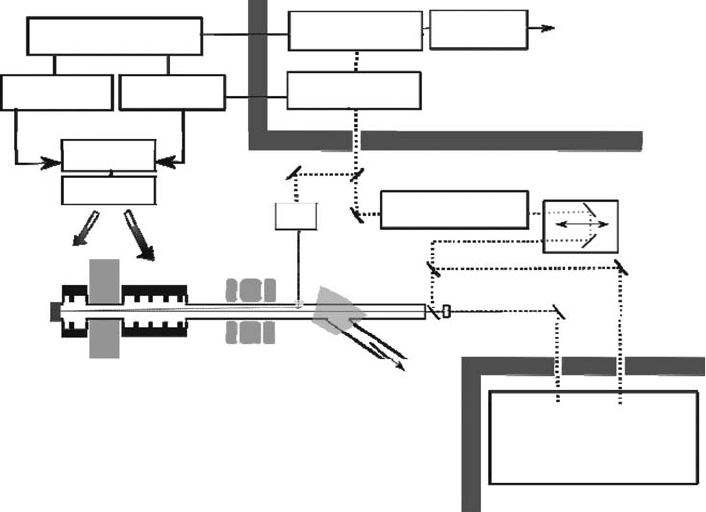
Time-Resolved Study on Nonhomogeneous Chemistry Induced in Polar Solvents 303
the generation of ultrashort bunches of electrons and charged particles are under tests and develop-
ments and already featured exciting research elds for pulse radiolysis (Brozek-Pluska etal., 2005;
Uesaka
etal., 2005; Oulianov etal., 2007).
12.4.1.3
picosecond
p
ulse-radiolysis
e
xperiments
u
sing
l
aser-driven
p
hotocathode
r
F
gun
The
six above-mentioned picosecond pulse-radiolysis, apart from variations specic to each facility, all
work on the same technical scheme, and at comparable levels of performances. A typical picosecond
pulse-probe experimental setup is illustrated in Figure 12.13, in the case of ELYSE. ELYSE is composed
of a photocathode RF gun and an accelerating section (booster), both powered by a single 20MW klys-
tron, and three beam-lines to transport and focus the electron bunches to the samples. Details about the
RF part of the machine can be found elsewhere (Belloni etal., 2004), as well as the description of the
installed pulse-radiolysis setups (Marignier etal., 2006). We focus here on the picosecond pulse-probe
setup. In the gun, the photoelectrons are emitted from a Cs
2
:Te photocathode illuminated by UV laser
pulses at 262nm. The original laser system of ELYSE has been recently upgraded. The actual congura-
tion is composed of a customized Trident laser system from Amplitude Technologies. Briey, it consists
of a femtosecond Ti:Sa laser oscillator (Femtolaser) synchronized at 78.9MHz on the phase of the RF
eld and used to seed a two stage amplier pumped at 100Hz synchronously with the accelerator. By
driving the Pockels cells of the amplier, the continuous 100Hz laser pulses train can be modulated
to extract at the repetition rate of the accelerator, either single laser pulses, or bunches of laser pulses
separated in time by 10ms. The energy per pulse is 2.3mJ, the pulse-width is 70–80fs and the emission
wavelength is centered at 785nm. Two thirds of this initial energy is converted at 262nm to generate the
UV laser pulse that is then seeded into the photocathode RF gun. If needed, the UV pulse duration can
be adapted before the injection into the accelerator vacuum tube by the means of appropriate dispersive
optics. Usually, a pulse with a duration in the range 1–5ps is preferred for the extraction and transport
of
electron bunches with a high charge per pulse (Wishart etal., 2004; Yang etal., 2006). The electron
Machine room
Level-2
Solenoid
Ce2:Te
photo
cathode
RF
gun
Booster
Klystron
THG
Supercontinuum
NOPA
Ti:Sa oscillator
785 nm
1 kHz–3 mJ
amplier
Femtolysis
Laser room
ground-oor
100 Hz–2.4 mJ
amplier
785 nm-80 fs
BS Optical probe
generation
50/50
Flowing
cell
282 nm
Optical
delay line
Modulator
2998.55 MHz 0.1–25 Hz
Quartz master clock
78.909 MHz
Focusing
magnets
Dipole
To the experimental
areas 2 and 3
Signal
Detection by photodiodes
or CCD camera
Detection room
Level-2
Reference
Figure 12.13 Ultrafast pulse-radiolysis system based on pulse-probe transient absorption spectroscopy.

304 Charged Particle and Photon Interactions with Matter
bunches generated at ELYSE possess an energy that can be continuously adjusted from 2 to 9MeV. The
charge in the bunch during pulse-radiolysis experiments is usually in the range 2–7 nC for an electron
pulse duration in the range 7–15ps.
The rest of the initial laser pulse is used to create tunable or broadband optical probes synchronized
with the electron pulses. Two kinds of femtosecond optical probes are available at ELYSE: (1) a white-
light supercontinuum probe, generated in a sapphire plate, with a typical spectral extension from 450nm
up to 850nm, and (2) an optical pulse generated by parametric amplication using a NOPA stage tunable
between 470 and 1600nm in the visible–NIR and, that can be frequency-doubled to reach the near-UV
(250–500nm) spectral region. The probe beam is propagated along a motorized optical delay line and
overlaps with the electron beam into the optical cell for pulse-probe transient absorption measurements.
Transient absorption spectroscopy in the UV–visible–NIR spectral domain is until now the
method widely used for picosecond pulse-radiolysis experiments. In a transient absorption experi-
ment, the time-dependent change in the absorbance A(t) of a species is measured and is directly
connected
with the time-dependent G-value of this species, G(t), by the relation
G t
A t
lD
( )
( )
=
ε
(12.1)
with
ε
(L mol
−1
cm
−1
), the species molar extinction coefcient
l
(cm
−1
), the optical path
D
(J kg
−1
) the dose
Providing that D and ε are known, the absolute G(t) function is directly deduced from measure-
ments. However, the accurate determination of the dose in the pulse-probe overlap volume is very
tedious. Therefore, the radiolytic yields are usually obtained indirectly from the knowledge of the
G-value at longer time delays or by comparison with the known G-value of another transient spe-
cies formed in the sample within the temporal window covered by the pulse-probe delay line of the
experiment. For this reason, the optical delay lines installed at picosecond pulse-radiolysis facility
preferentially
extend up to 5–15
ns
in order to recover with the data measured at the ns timescale.
Transient
absorption is acquired by consecutively recording the intensity of the laser with (I) and
without (I
0
) electron pulse applied to the sample. The shot-to-shot uctuation of the probe laser must
be compensated by simultaneously measuring the intensity uctuation of a reference probe beam
(I
ref
and
I
ref
0
, respectively) created by a 50/50 beam splitter placed on the optical probe pathway
before the sample. Synchronized contributions to the signals from the electronic devices or from
parasite light (Cherenkov …) are rejected by recording the intensity on the detectors in the absence
of optical probe (I
dark
,
I
dark
ref
). The probe and reference signals, (I, I
0
, I
dark
)
mes
and (I, I
0
, I
dark
)
ref
, are
measured by using either two photodiodes or two separated areas of a multichannel CCD camera.
The
transient absorbance is then given by the formula
A t
I I
I I
I I
I I
( )
( )
( )
( )
( )
dark
dark
mes
dark
dark
=
−
−
−
−
0
0
rref
(12.2)
where
t is the pulse-probe time delay.
This
acquisition scheme is classical for pump-probe transient absorption spectroscopy setup, and
is also implemented at LEAF and NERL. However, it must be mentioned that the environmental
conditions in a picosecond pulse-radiolysis facility cannot be so nely controlled than in standard
laser labs and so, the experiments are much more affected by vibrations and thermal uctuations.
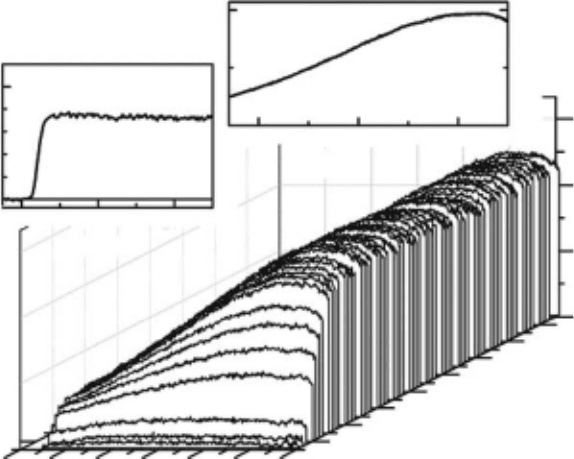
Time-Resolved Study on Nonhomogeneous Chemistry Induced in Polar Solvents 305
To reduce the inuence of these factors, the acquisition scheme at ELYSE is based on the genera-
tion of a probe laser bunch containing two laser pulses separated by 10ms, corresponding to I and
I
0
, respectively. By this way, the perturbation induced by the noise in the hertz frequency range
is reduced. The signal A(t) can be acquired at a repetition rate up to 25Hz using photodiodes or a
CCD camera. Thesensitivity of the detection setup is typically better than 1 mOD for an average
of 10 laser probe pulses, that is, in the order of magnitude of the shot-noise limit. Figures 12.14 and
12.18 illustrate the sensitivity routinely obtained with the multichannel (CCD) or the monochannel
(photodiodes) pulse-probe setups installed at ELYSE, respectively.
At Osaka University, Yang etal. (2006) have developed an alternative acquisition scheme. The
RF gun is triggered by a Nd:YLF picosecond laser, while a second Ti:Sa oscillator is mode-locked
at the repetition rate of 79.3MHz in phase with the 36th harmonic of the 2856 accelerating RF
eld and is used to generate the synchronized optical probe beam. A so-called double pulse can be
extracted from the laser train to create the I
0
, and I probe pulse, respectively. For this conguration,
no references are needed, considering that the noise in the 80 MHz bandwidth is very low. The same
group also performs pulse-probe measurements using optical probe pulse delivered by OPAs, or
by generation of a white-light supercontinuum. In the latter case, they operate a 1kHz regenerative
amplier, and the same double-pulse acquisition scheme is still applied at 1kHz (Saeki etal., 2006).
The time resolution in transient absorption spectroscopy depends on three parameters: the electron
pulse duration, the jitter between the arrival times of the electron pulse and the laser probe pulse, and
the velocity mismatch between the relativistic electron bunch traveling at a speed close to the light
20
750700650600
Time (ps)
0
0
100
mOD
100
Decay@700 nm
B
200
500 600
Spectrum@30 ps
λ (nm)
700
0
75
mOD
550500450
40
60
80
100
Delay (ps)
120
140
160
0
30
60
mOD
90
Figure 12.14 Transient absorption spectra and decay of the solvated electrons in water measured by pulse-
probe spectroscopy. The charge and the energy of electrons pulses were 3 nC and 8.3MeV, respectively. The
electron pulse duration, deduced from the rise time of the absorption signal, was shorter than 10ps. The optical
probe beam consisted of supercontinuum pulses generated in a sapphire plate and was detected on a multichan-
nel CCD camera. At every step along the pulse-probe delay scan, the single-shot transient absorption spectra
were measured at the repetition rate of the accelerator (on this case 10Hz, but the acquisition setup can work
up to repetition rate of 50Hz). In the 3D graph, each spectrum has been obtained by averaging 10 single-shot
acquisitions. The full scan extended over a pulse-probe delay between −20 and 250ps, with a 2ps step. Left inset:
Time-dependent absorbance at λ
probe
= 700nm, reconstituted from the same series of transient spectra. Right
inset: Spectrum of solvated electrons recorded 30ps after the electron pulse and averaged over 50 electron pulses.
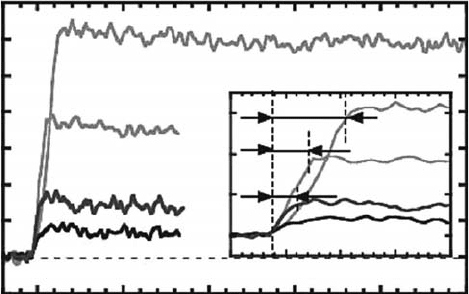
306 Charged Particle and Photon Interactions with Matter
celerity, c, and the optical probe traveling at the speed c/n with n the refractive index of the sample.
The time jitter between the laser and the electron pulses is governed by the phase stability between the
mode-locked oscillator and the RF accelerating wave. Shot-to-shot jitter in the range of 1ps rms, are
routinely obtained at picosecond pulse-radiolysis facilities. At ELYSE, the typical electron pulse dura-
tion for pulse-probe experiments is 8ps for a charge of 2–5 nC. Similar bunch properties are available
at LEAF (>7ps for 6–8 nC). Both facilities are operated with beam energy slightly below 9MeV and
without a magnetic bunch compressor inserted in the electron beam transportation. NERL and ISIR
facilities are equipped with inserted compressing devices, and deliver electron bunches accelerated up
to 30MeV. A signicant advantage of acceleration at higher energy is a better focusing of the electron
beam that allows the deposition of dose as high as 40Gy/shot and, at the same time, keeping the charge
per bunch in the range of 2 nC and a duration compressed down to 2ps. Electron bunches shorter than
500fs, for a charge of 1.25 nC have also been reported. While short electron bunches are available,
for many studies it is often preferred to record signals at a high S/N ratio. Toward this end, the optical
path in the sample is kept around 5mm, and the time resolution is reduced due to the velocity mis-
match between the laser and the electron bunch. As an example, the time-of-ight difference between
an electron bunch and a laser pulse at 600nm, traveling collinearly in water, is about 1ps mm
–1
of
sample. Figure 12.15 illustrates the changes in the time resolution due to the increase in the optical
path length. A good estimation of the time resolution, τ
min
, of a transient absorption measurement in
collinear geometry is given by (Kashiwagi etal., 2005; Muroya etal., 2008)
( )τ τ τ τ τ
min vel puls las jitter
.
= + + +
2 2 2 0 5
(12.3)
where τ
vel
, τ
puls
, τ
las
and τ
jitter
represent the time-of-ight difference, the electron pulse duration, the
laser probe pulse duration, and the arrival time jitter, respectively. Methods are available to directly
measure the shot-to-shot jitters and the bunch length longitudinal prole (De Waele etal., 2009), from
which the exact response function of the detection system can be calculated (Wojcik etal., 2004).
Transient absorption spectroscopy is well adapted to study the time dependence of the G-values,
due to its sensitivity and the absolute characters of the measured absorbance. In practice, the record
of kinetics is often limited by the stability of the electron accelerator itself due to slow time drift
during the acquisition. So, a lot of effort is also put to stabilize the machines, and notably the
phase of the klystron and the long-term laser beam pointing. These parameters are strongly coupled
0.35
0.30
0.25
0.20
0.15
Absorbance
0.10
0.05
0.00
–0.05
0 50
(d)
(c)
(b)
(a)
0.3
0.2
0.1
0.0
–10 0 10
<4 ps
4–5 ps
6–7 ps
–13 ps
20 30
100
Time (ps)
150 200 250
Figure 12.15 Time behavior of hydrated electron measured at 700 nm. Inset: enlarged part of the gure
within 30ps. Optical path lengths of the cells are (a) 10mm, (b) 5mm, (c) 2 mm, and (d) 1 mm. Pulse-probe
measurements at the NERL pulse-radiolysis facility. (Reprinted from Muroya, Y. etal., Radiat. Phys. Chem.,
77,
1176, 2008. With permission.)
Time-Resolved Study on Nonhomogeneous Chemistry Induced in Polar Solvents 307
with the environmental conditions of the facility (air temperature, cooling systems stability, etc.).
Alternatively, setups for transient absorption spectroscopy are under development with the aims
of decreasing the acquisition time. At Brookhaven, A. Cook and J. Wishart have developed a setup
based on a temporally dispersed optical probe beam by using a bundle of 100 optical-bers of
different lengths as delay line to simultaneously record the transient absorbance at 100 different
pulse-probe delays, keeping the high temporal resolution permitted by the pulse-probe method.
At ELYSE, J.L. Marignier is exploiting a high-dynamic range streak-camera with picosecond time
resolution coupled with a powerful home-made ash lamp working at 25Hz, to simultaneously
record the spectral changes and the kinetics induced by the electron beam. One advantage of this
system is that the same setup allows measurements on different temporal windows from 0–500ps to
several microseconds (Marignier etal., 2006). Another approach has been proposed by Bartels and
coworkers, based on a 30ps/20 MeV linac, combined with an asynchronous Ti:Sa used for perform-
ing time-correlated absorption spectroscopy (Bartels etal., 2000). The resulting time resolution is
lower than that of the previously described systems, and the spurs dynamics can be investigated
with
a high S/N ratio over a large temporal window of tens of nanoseconds.
12.4.2 recent advanceS in SpurS cheMiStry obtained by picoSecond pulSe-radiolySiS
Water decomposes under ionizing radiation into
e
aq
−
, OH
•
, H
3
O
+
, H
•
, H
2
, and H
2
O
2
. These radicals
and molecular products are formed in the spurs during the physicochemical stage according to the
following
primary reactions:
H O e + H O
2 2
+
→
−
(I)
H O H O
*
2 2
→ (II)
Followed
by
e + H O OH +H H +OH +OH
2 2
− − −
→
i i
→
(III)
e H O e
2 aq
− −
+ →n (IV)
H O
*
H OH
2
→ +
i
(Va)
H O
*
H O H +2OH (or H O )
2 2 2 2 2
+ →
i
(Vb)
H O + H O OH H O
2
+
2 3
+i i
→ +
(VI)
The secondary electrons formed during reaction (I) that escape geminate recombination with their
H
2
O
•
+
parent cation can react with water molecules according to reaction (III) and are the source for
the so-called unscavengable H
2
production. The main part of the low-energy electrons is thermal-
ized and becomes hydrated according to (IV), as discussed in Section 12.3. The excited water mol-
ecules decompose directly or by reaction with a neighbor molecule to form H, H
2
, OH
•
, and H
2
O
2
species. H
2
O
•
+
reacts according to (VI) and is the major source of OH
•
. The reactions (I) through
(VI) are responsible for the initial yields, that is, G-values for the primary radiolytic products of
water.
Then, the species evolve in the spurs, according to the spurs reactions listed in Table 12.1.
12.4.2.1
time-dependent
G-
value
of s
olvated
electron in w
ater
The time-dependent measurement of solvated electron yield at a short-time range was carried out in
water by Bronskil etal. (1970) with a time resolution of 30ps. Then, several groups focused on mea-
suring time-dependent escape probability with different fast techniques. By using pulse techniques

308 Charged Particle and Photon Interactions with Matter
(Hunt etal., 1973; Jonah etal., 1973, 1976; Wolff etal., 1973, 1975; Sumiyoshi and Katayama, 1982;
Sumiyoshi etal., 1985), different values were reported for G(t). The initial yield of formation of the
hydrated electron was revisited in the last decade with the state-of-the-art pulse-radiolysis systems.
Bartels and coworkers measured the decay of hydrated electrons in H
2
O and D
2
O on a continu-
ous time window up to 200ns by combining time-correlated absorption spectroscopy and standard
time-resolved absorption measurements with ns time resolution (Bartels etal., 2000). The initial
formation yield of hydrated electron was obtained by extrapolation of the tted decay and found
to be G = 4.2 × 10
−7
mol J
−1
in light water. In heavy water, the value of 4.3 × 10
−7
mol J
−1
and a
slower decay during the rst 10ns were reported (Bartels etal., 2001). This isotopic effect had
already been observed and is associated with a larger escape distance covered by the electron due
to lower vibrational modes of heavy water compared to light water. The initial G-value for hydrated
electron in H
2
O was measured directly with a higher time resolution by Muroya etal. who reported a
value of G= (4.2 ± 0.2) × 10
−7
mol J
−1
(Muroya etal., 2005b). These two new measurements of the
G-values are in good agreement but signicantly lower (20%) than the previously adopted value
of 4.8 × 10
−7
mol J
−1
. Monte Carlo calculations have been parameterized to take into account this
new data (Muroya etal., 2002). According to Jay-Gerin and coworkers, an initial yield equal to
4.0 × 10
−7
mol J
−1
cannot be tted by the stochastic model, and a value of (4.4–4.5) × 10
−7
mol J
−1
is proposed instead, associated with an average initial thermalization distance equal to 13.9nm
(equivalent to a spur radius of 8.7 nm) and a yield for the electron–cation recombination of 18%, in
good agreement with experimental data. The time-dependent G-value measured by Muroya etal.
and the comparison with the Monte Carlo simulation are reported in Figure 12.16, together with the
decay measured by Bartels and coworkers (Bartels etal., 2000).
table 12.1
main
r
eactions
i
nvolved
in the r
adiolysis
of
Cl
−
Concentrated solutions
reactions rate Constant (l m
−1
s
−1
)
e e H O H HO
hyd hyd
− − −
+ + → +2 2
2 2
5.5 × 10
9
e H O H H O
hyd
− +
+ → +
3 2
•
1.3 × 10
10
e H H HO
hyd
− −
+ → +
•
2
2.5 × 10
10
HO e HO
hyd
•
+ →
− −
3 × 10
10
e H O HO HO
hyd
− −
+ → +
2 2
•
1.1 × 10
10
H O HO H O
3 2
2
+ −
+ →
1.4 × 10
11
H H H
• •
+ →
2
7.8 × 10
9
HO H H O
• •
+ →
2
2 × 10
10
H H O H O HO
•
+ → +
−
2 2 2
9 × 10
7
HO HO H O
• •
+ →
2 2
5.5 × 10
9
e H O H H O
hyd
− +
+ → +
3 2
•
1.3 × 10
10
H O HO H O
3 2
2
+ −
+ →
1.4 × 10
11
H O O HO H O
3 2 2 2
+ −
+ → +
• •
3.8 × 10
10
HO Cl ClOH
• •
+ →
− −
4.3 × 10
9
ClOH HO Cl
• •− −
→ +
6.1 × 10
9
ClOH H Cl H O
• •− +
+ → +
2
2.1 × 10
10
Cl Cl Cl
• •
+ →
− −
2
8.9 × 10
9
Cl H H O H O Cl
2 2 3
2
• •− + −
+ + → +
8.9 × 10
9
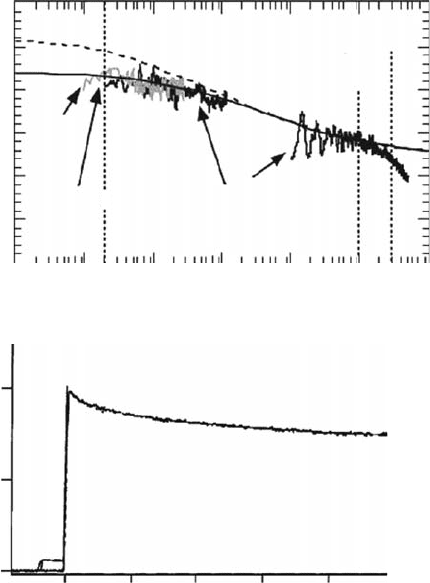
Time-Resolved Study on Nonhomogeneous Chemistry Induced in Polar Solvents 309
The initial G-value is governed by the ultrafast physical processes, in particular geminate
recombination, that could take place within the rst few hundreds of femtoseconds. A new type
of accelerator based on the laser-plasma acceleration technique could in principle give access
to this temporal window. At the moment, the time resolution is not better than that of linac
accelerators, but these pioneering works are encouraging despite the difculties of these types
of measurements. Electron pulses of relativistic energies (1.5–20 MeV) generated by a terawatt
laser-wakeeld accelerator (LWA) have been used for ultrafast pulse-radiolysis experiments.
Brozek-Pluska etal. (2005) and Oulianov etal. (2007) reported the rst pulse-radiolysis experi-
ments using LWA technique. In both experiments the decay of hydrated electron is probed in the
NIR by pulse-probe transient absorption. LWA technique is capable of generating subpicosecond
electron bunches with a charge of a few nanocoulombs. However, due to the geometric congura-
tion of the pulse-probe setups (sample thickness, non-collinear geometry) and the dispersion in
energy of the electron bunch, the effective time resolution was limited to a few picoseconds. The
signals obtained by the two groups are reported in Figure 12.17. The data from Brozek-Pluska
etal. (2005) (Figure 12.17, left) show an instantaneous formation of the signal within the time
resolution of the setup (3.5 ps), followed by a strong decay of the absorbance that is divided by a
factor two during the rst 50 ps after the irradiation by the electron bunch pulse. The associated
G-value, at 3.5 ps, is 7 × 10
−7
mol J
−1
. This value and the kinetics of the decay are in disagreement
0.10
0.05
0.00
0 2 4
Time (ns)(b)
ΔOD
6 8
G°(t)/G
inf
= 1 + 0.090 exp (–t/139 ns)
+ 0.128 exp (–t/24.4 ns)+ 0.255 exp(–t/3.51 ns)
+ 0.118 exp(–t/0.480 ns)
6
5
4
3
2
1
0
10
–12
10
–11
10
–10
10
–9
Time (s)
(a2)
(a1)
(b1)
(b2)
G(e
aq
–
) = 2.7
G-value/molec. (100 eV)
–1
G(e
aq
–
) = 2.38
10
–8
10
–7
10
–6
(a)
G(e
aq
–
) = 4.1
Figure 12.16 Recent revisited time-dependent G-values, G(t), of hydrated electrons in water at 25°C, mea-
sured by pulse-radiolysis technique. (a) Spur decay kinetics of the hydrated electron following picosecond pulse
radiolysis of water measured using a time-correlated transient absorption technique, and the deduced functional
expression for G(t). (Adapted from Bartels, D.M. etal., J. Phys. Chem. A, 104, 1686, 2000. With permission.)
(b) Time-dependent G-value measured by picosecond pulse-probe technique and compared with Monte Carlo
calculations. (Reprinted from Muroya, Y. etal., Radiat. Phys. Chem., 72, 169, 2005b. With permission.)
